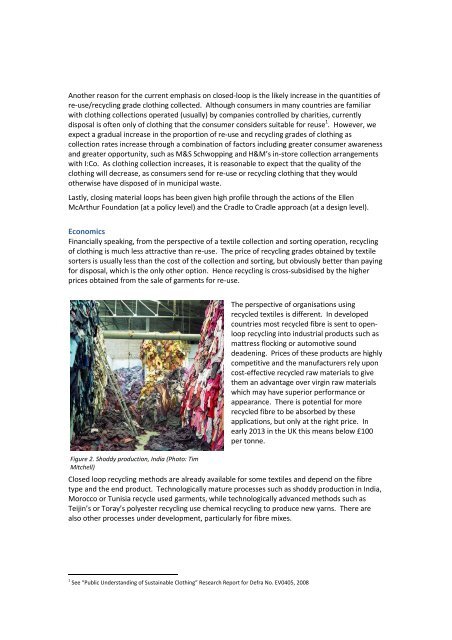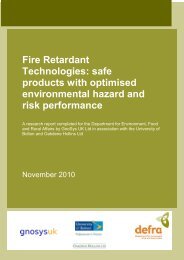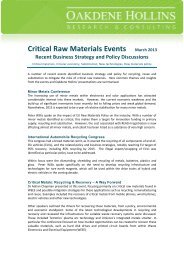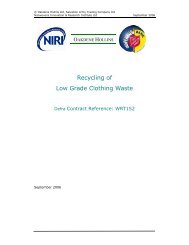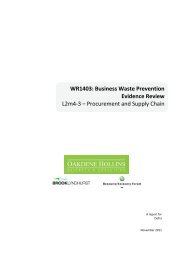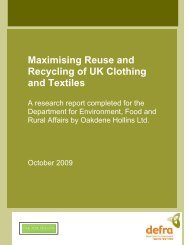Closing the Loop for clothing - Oakdene Hollins
Closing the Loop for clothing - Oakdene Hollins
Closing the Loop for clothing - Oakdene Hollins
Create successful ePaper yourself
Turn your PDF publications into a flip-book with our unique Google optimized e-Paper software.
Ano<strong>the</strong>r reason <strong>for</strong> <strong>the</strong> current emphasis on closed-loop is <strong>the</strong> likely increase in <strong>the</strong> quantities of<br />
re-use/recycling grade <strong>clothing</strong> collected. Although consumers in many countries are familiar<br />
with <strong>clothing</strong> collections operated (usually) by companies controlled by charities, currently<br />
disposal is often only of <strong>clothing</strong> that <strong>the</strong> consumer considers suitable <strong>for</strong> reuse 1 . However, we<br />
expect a gradual increase in <strong>the</strong> proportion of re-use and recycling grades of <strong>clothing</strong> as<br />
collection rates increase through a combination of factors including greater consumer awareness<br />
and greater opportunity, such as M&S Schwopping and H&M’s in-store collection arrangements<br />
with I:Co. As <strong>clothing</strong> collection increases, it is reasonable to expect that <strong>the</strong> quality of <strong>the</strong><br />
<strong>clothing</strong> will decrease, as consumers send <strong>for</strong> re-use or recycling <strong>clothing</strong> that <strong>the</strong>y would<br />
o<strong>the</strong>rwise have disposed of in municipal waste.<br />
Lastly, closing material loops has been given high profile through <strong>the</strong> actions of <strong>the</strong> Ellen<br />
McArthur Foundation (at a policy level) and <strong>the</strong> Cradle to Cradle approach (at a design level).<br />
Economics<br />
Financially speaking, from <strong>the</strong> perspective of a textile collection and sorting operation, recycling<br />
of <strong>clothing</strong> is much less attractive than re-use. The price of recycling grades obtained by textile<br />
sorters is usually less than <strong>the</strong> cost of <strong>the</strong> collection and sorting, but obviously better than paying<br />
<strong>for</strong> disposal, which is <strong>the</strong> only o<strong>the</strong>r option. Hence recycling is cross-subsidised by <strong>the</strong> higher<br />
prices obtained from <strong>the</strong> sale of garments <strong>for</strong> re-use.<br />
Figure 2. Shoddy production, India (Photo: Tim<br />
Mitchell)<br />
The perspective of organisations using<br />
recycled textiles is different. In developed<br />
countries most recycled fibre is sent to openloop<br />
recycling into industrial products such as<br />
mattress flocking or automotive sound<br />
deadening. Prices of <strong>the</strong>se products are highly<br />
competitive and <strong>the</strong> manufacturers rely upon<br />
cost-effective recycled raw materials to give<br />
<strong>the</strong>m an advantage over virgin raw materials<br />
which may have superior per<strong>for</strong>mance or<br />
appearance. There is potential <strong>for</strong> more<br />
recycled fibre to be absorbed by <strong>the</strong>se<br />
applications, but only at <strong>the</strong> right price. In<br />
early 2013 in <strong>the</strong> UK this means below £100<br />
per tonne.<br />
Closed loop recycling methods are already available <strong>for</strong> some textiles and depend on <strong>the</strong> fibre<br />
type and <strong>the</strong> end product. Technologically mature processes such as shoddy production in India,<br />
Morocco or Tunisia recycle used garments, while technologically advanced methods such as<br />
Teijin’s or Toray’s polyester recycling use chemical recycling to produce new yarns. There are<br />
also o<strong>the</strong>r processes under development, particularly <strong>for</strong> fibre mixes.<br />
1 See “Public Understanding of Sustainable Clothing” Research Report <strong>for</strong> Defra No. EV0405, 2008


